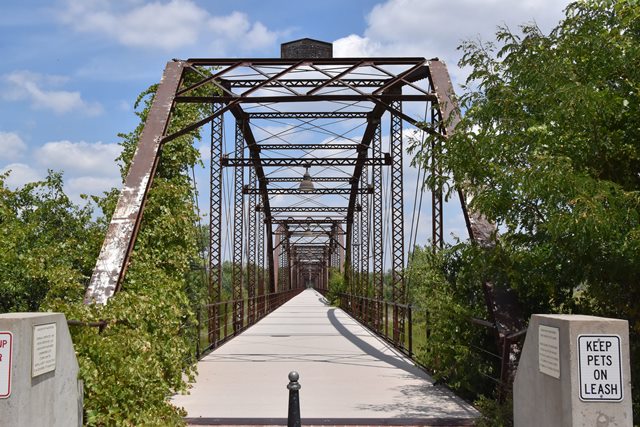We Recommend:
Bach Steel - Experts at historic truss bridge restoration.
BridgeHunter.com Phase 1 is released to the public! - Visit Now
Canadian River Wagon Bridge

Primary Photographer(s): Nathan Holth
Bridge Documented: August 3, 2019
Pedestrian Walkway (Former US-60 and US-83) Over Canadian River
Canadian: Hemphill County, Texas: United States
Metal 7 Panel Pin-Connected Pratt Through Truss, Fixed and Approach Spans: Metal Rivet-Connected Warren Pony Truss, Fixed
1916 By Builder/Contractor: Canton Bridge Company of Canton, Ohio
2000
155.0 Feet (47.2 Meters)
3,255.0 Feet (992.1 Meters)
16 Feet (4.88 Meters)
19 Main Span(s) and 2 Approach Span(s)
Not Applicable

View Information About HSR Ratings
Bridge Documentation
View Historic American Engineering Record (HAER) Documentation For This Bridge
HAER Data Pages, PDF
This bridge is the longest known simple span pin connected highway truss bridge in the entire country. After being abandoned without a deck for many decades, the bridge was redecked for pedestrian use. Considering the length of the bridge, this is a very impressive preservation success story!
The history of the bridge is somewhat confusing. The Historic American Engineering Record states the following:
This 3,255'-0"-long structure is the longest pin-connected bridge in Texas, and was the state's longest metal truss bridge prior to the completion of the Rainbow Bridge connecting Orange and Port Arthur in 1938. Two previous bridges at this site built in 1888 and 1889 were washed away by floods, and after some delays, voters finally approved a 1915 initiative to build a more permanent crossing of the river. The structure completed in 1916 included seventeen 155'-0" long and 27'-0" high pin-connected Parker through trusses for a 2,635'-0" total length. The 16'-0" roadway rested atop concrete piers with steel footings driven 65'-0" into the riverbed. When high water widened the river in 1923, the county paid the Austin Bridge Company of Dallas to provide four additional Parker through trusses with the same dimensions and the same substructure. This increased the bridge's length by 620'-0". By the 1950s, the 16'-0" roadway had become too narrow to safely carry passing traffic. In 1953, a new $1 million concrete and steel structure, built with state highway funds by the Austin Bridge Company of Dallas, bypassed the original bridge.
Assuming the above history is correct, the four additional spans from 1923 are identical to the 1916 spans. This would be unusual since by the 1920s, pin-connected truss spans were no longer being built. Even the 1916 spans are late examples of pin-connected truss bridges. Also, missing from the Historic American Engineering Record, is the fact that one of the pin-connected Parker truss spans (the fourth span from the north end) were replaced with two rivet-connected Warren pony truss spans. It is unclear what date this occurred. The Warren pony truss spans are of standard riveted design.
This is an extremely difficult bridge to get a photo showing the whole bridge. Drone videos of the bridge are available on YouTube. View Drone Video 1 and View Drone Video 2.
![]()
Photo Galleries and Videos: Canadian River Wagon Bridge
Bridge Photo-Documentation
Original / Full Size PhotosA collection of overview and detail photos. This gallery offers photos in the highest available resolution and file size in a touch-friendly popup viewer.
Alternatively, Browse Without Using Viewer
![]()
Bridge Photo-Documentation
Mobile Optimized PhotosA collection of overview and detail photos. This gallery features data-friendly, fast-loading photos in a touch-friendly popup viewer.
Alternatively, Browse Without Using Viewer
![]()
Maps and Links: Canadian River Wagon Bridge
Coordinates (Latitude, Longitude):
Search For Additional Bridge Listings:
Bridgehunter.com: View listed bridges within 0.5 miles (0.8 kilometers) of this bridge.
Bridgehunter.com: View listed bridges within 10 miles (16 kilometers) of this bridge.
Additional Maps:
Google Streetview (If Available)
GeoHack (Additional Links and Coordinates)
Apple Maps (Via DuckDuckGo Search)
Apple Maps (Apple devices only)
Android: Open Location In Your Map or GPS App
Flickr Gallery (Find Nearby Photos)
Wikimedia Commons (Find Nearby Photos)
Directions Via Sygic For Android
Directions Via Sygic For iOS and Android Dolphin Browser
USGS National Map (United States Only)
Historical USGS Topo Maps (United States Only)
Historic Aerials (United States Only)
CalTopo Maps (United States Only)


